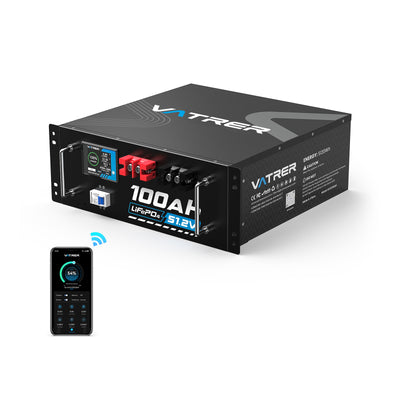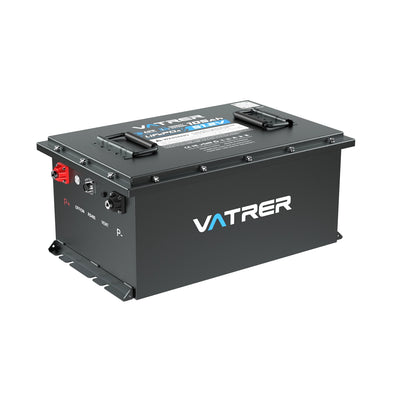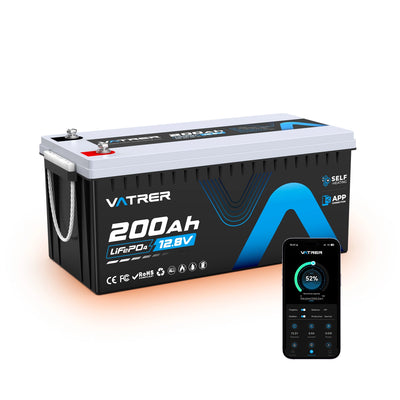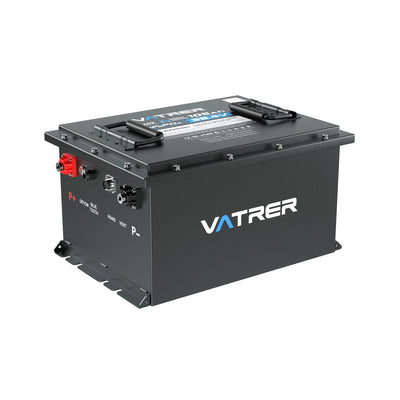
Group 24 vs Group 27 vs Group 31 Batteries: What's the Difference
Choosing a suitable battery for your motorhome, boat, or off-grid solar system can feel like working through a maze of technical labels such as group 24 battery, group 27 battery, and group 31 battery. These designations, created by the Battery Council International (BCI), are the reference point for making sure the battery not only fits the compartment but also supports your journeys. Whether you are powering a trolling motor on a small fishing boat, running lights and appliances in an RV, or building a reliable off-grid power bank, understanding these battery group sizes is essential.
This guide explains the distinctions between Group 24, Group 27 and Group 31 batteries—covering physical dimensions, capacity, price and typical use cases. With clear specifications, practical comparisons and a simple decision framework, you will be able to choose the right battery group with confidence. Let’s get started.

What Are BCI Group Sizes? Why Correct Fit Is So Important
Have you ever noticed labels such as “Group 24” or “Group 31” on batteries? These are BCI group sizes, a standard introduced by the Battery Council International that defines a battery’s external dimensions—length, width, height—as well as terminal style and position (for example, top-post SAE or side-stud, left or right). You can think of it as a common language that helps ensure the battery sits properly in your RV, boat or solar installation without needing to reroute cables or modify the battery tray.
BCI group numbers are used across a wide range of sectors, including automotive, marine and leisure vehicles. This means a group 24 battery is designed to fit into any correctly sized tray, whether installed on a sailing yacht or in a commercial vehicle. If the group size is wrong, you may end up with poor terminal contact or cables that are stretched too far, which can result in intermittent power on the road or on the water.
Always begin by measuring the battery compartment and noting the terminal layout. This helps ensure a straightforward drop-in replacement. Next, let’s compare how Group 24, 27 and 31 differ in size and mass.
Size, Weight, and Fit: Matching the Battery Group to Your Space
Getting the physical fit correct is the first priority—no matter how impressive the specifications, a battery that does not fit the tray is of little use.
- Different Size: Group 24 batteries are the most compact option, well suited to tight installations such as kayaks or smaller campervans. Group 27 batteries are slightly longer and offer a compromise between capacity and footprint for medium-sized systems. Group 31 batteries, larger than group 24 batteries, require more room but are designed for higher-demand power banks.
- Weight varies by chemistry: Traditional lead-acid batteries are relatively heavy because of their internal lead plates, whereas lithium models such as a Vatrer battery can reduce the weight by as much as 70%. Before purchasing, measure the battery bay carefully (allow around 0.25–0.5 inches of clearance for straps and movement) and check that the cables will reach comfortably without sharp bends. Taller Group 31 batteries may also require longer hold-down bolts or revised brackets, so verify bolt length and fixing points to avoid an unstable installation.
- Ventilation: Airflow is another consideration—flooded lead-acid batteries can release gases during charging and therefore need ventilation, while sealed AGM or lithium deep cycle batteries are better suited to compartments with limited ventilation.
Below is a quick comparison of the main physical characteristics of these battery groups according to BCI guidelines. It also helps illustrate why Group 24 is often chosen for a trolling motor battery where space is tight, while Group 31 is a better fit for larger installations.
| Feature | Group 24 | Group 27 | Group 31 |
|---|---|---|---|
| Dimensions (L × W × H, inches) | 10.25 × 6.81 × 8.88 inches | 12.06 × 6.81 × 8.90 inches | 13.00 × 6.81 × 9.44 inches |
| Capacity (Ah) | Lead-acid: 70–85Ah Lithium: 100Ah | Lead-acid: 85–105Ah Lithium: 100–120Ah | Lead-acid: 95–125Ah Lithium: 100–140Ah |
| Weight (lbs) | Lead-acid: 40–50 lbs Lithium: 20–30 lbs | Lead-acid: 50–65 lbs Lithium: 25–35 lbs | Lead-acid: 60–75 lbs Lithium: 30–40 lbs |
| Best for | Small boats, kayaks, etc. with limited space | Medium-sized sailboats and motorhomes | Large RVs, yachts, off-grid solar systems |
| Cost (initial purchase) | Lead-acid: $80–$150 Lithium: $200–$400 | Lead-acid: $100–$200 Lithium: $250–$500 | Lead-acid: $150–$300 Lithium: $300–$600 |
Capacity and Power: How Group 24, 27, and 31 Batteries Perform in Practice
For any RV, sailing boat or off-grid solar bank, the crucial question is: how long will the battery keep your equipment running? Capacity, expressed in ampere hours (Ah), indicates how much energy the battery can store, but the usable portion depends heavily on the battery chemistry. Lead-acid deep-cycle batteries should generally not be discharged beyond about 50% to avoid damage, whereas Vatrer lithium batteries can safely offer around 80–100% of their rated capacity for everyday use, providing a noticeably longer runtime.
- Group 24: Typically gives 70–85Ah in lead-acid form (~35–42Ah usable) or around 100Ah for lithium (~80–100Ah usable), making it suitable for lighter loads such as a trolling motor on a kayak or small boat.
- Group 27: Usually offers 85–105Ah for lead-acid (~42–52Ah usable) or roughly 100–120Ah for lithium (~80–120Ah usable), ideal for moderate RV leisure battery demands.
- Group 31: Provides about 95–125Ah for lead-acid (~47–62Ah usable) or approximately 100–140Ah for lithium (~80–140Ah usable), well matched to higher-load systems such as yachts or off-grid cabins.
As an illustration, a 12V compressor fridge drawing around 60W for 12 hours (720Wh) will require roughly 60Ah per day. A Group 24 lead-acid battery may be pushed to its limits in this scenario, whereas a Group 27 lithium or Group 31 bank manages the demand far more comfortably.
Lithium batteries also maintain a flatter discharge curve, so they deliver consistent voltage to RV appliances or trolling motors, while lead-acid voltage gradually drops as the battery discharges.
Reserve capacity (RC), which indicates how long the battery can deliver 25 amps, helps compare runtime: Group 24 is often around 120–150 minutes, Group 27 roughly 140–180 minutes, and Group 31 generally 180–230 minutes.
Vatrer lithium batteries add smart functions such as low-temperature protection, self-heating options and Bluetooth monitoring, providing dependable performance throughout the year whether you are touring in a motorhome or navigating offshore. You can also estimate your daily consumption using the Vatrer online calculator to select an appropriate battery pack for your specific loads.
For combined starter and service duties (for example, cranking an inboard engine as well as powering accessories), lead-acid may still be preferred, as most lithium units are optimised for deep-cycle use and not designed as high-cranking starter batteries.
Cost vs. Value: Comparing Group 24, 27, and 31 Battery Pricing
When investing in a new battery bank, overall budget is usually a key factor in the decision.
- Lead-acid batteries are cheaper at the point of purchase. Among them, Group 24 batteries are typically the least expensive, from around $80–$150, and work well for small boats or as backup storage. Group 27 lead-acid options usually cost about $100–$200 and offer a good mid-range solution for campervans or caravans. Group 31 lead-acid batteries, which provide higher capacity, often fall in the $150–$300 bracket.
- By contrast, lithium batteries have a higher upfront price, typically about $200–$400 for Group 24, $250–$500 for Group 27, and $300–$600 for Group 31. However, the long-term economics are more favourable: with around 3,000–5,000 charge cycles (compared with roughly 300–500 for lead-acid), lithium packs usually need replacing far less often and can reduce lifetime battery spend by an estimated 30–50% over ten years. On top of this, Vatrer lithium batteries come with strong warranty cover, while lead-acid warranties are often only 1–3 years, giving regular RV or boat users more peace of mind.
Looking at the wider picture, lithium batteries not only reduce replacement frequency but are also lighter—helping to cut fuel consumption for motorhomes or boats—and recharge much faster. Typical lithium charging times are in the range of 1–4 hours, whereas lead-acid batteries often require 8–15 hours for a full charge.
Multipurpose Use: Group 24, 27, and 31 Batteries for RVs, Boats, and Solar
Choosing the most suitable battery group means aligning its capabilities with how you actually use your equipment—whether that is occasional fishing trips, extended touring in a camper, or a permanent off-grid solar installation. Group 24, Group 27 and Group 31 batteries each have strengths depending on their size, capacity and power output.
- Group 24: These smaller batteries are designed for installations where space is very limited, such as kayaks or compact open boats. They are well suited to acting as a trolling motor battery on a small fishing craft or powering low-consumption devices such as LED lighting or a small bilge pump during a day on the water. Their modest capacity means they are best for shorter outings or lighter loads. For example, a Vatrer Group 24 lithium battery can power a kayak trolling motor for around 6–8 hours, with none of the maintenance tasks associated with a flooded lead-acid battery, which often needs electrolyte checks every 1–2 months.
- Group 27: Offering a useful balance of footprint and capacity, Group 27 batteries are a popular choice for medium-sized sailing boats or RV leisure battery banks. They can support moderate loads—for instance, a fridge, interior lighting and a fan for a weekend of wild camping in a campervan. Their slightly larger size still fits many standard battery trays, making them flexible choices for marine or solar energy systems with daily demands of roughly 700–1,000Wh.
- Group 31: Intended for higher-demand applications, Group 31 batteries work well in yachts, large motorhomes or more substantial off-grid solar systems. They can support power-hungry equipment such as inverters or air-conditioning units for extended periods, making them suitable for full-time off-grid living or longer passages at sea. The larger casing does require adequate space, but in return you gain significantly longer runtime. For instance, a Vatrer Group 31 battery can run a yacht’s onboard systems for 10–12 hours, and its low-temperature protection helps maintain reliability during winter, unlike lead-acid batteries which need regular electrolyte inspections.
Vatrer lithium battery packs combine low weight, greater usable depth of discharge and zero routine maintenance, making them a strong match for a wide variety of use cases.
How to Choose Your Group 24, 27 or 31 Battery
Once you understand how Group 24, Group 27 and Group 31 batteries behave in RV, marine and solar systems, the final step is to select the group that best suits your specific situation. The following points can help guide your decision and ensure reliable power wherever you travel.
- Assess Your Space: Begin by measuring the battery compartment (length, width and height), leaving about half an inch of clearance for straps and movement. Confirm the terminal style (SAE post or stud) and polarity layout to avoid cable routing issues. If space is restricted, a compact option such as the Vatrer Group 24 lithium battery provides high capacity in a small footprint.
- Calculate Power Needs: Use a battery calculator to total your daily energy consumption in Wh and match this to a suitable battery group, ensuring sufficient runtime for your heaviest-draw devices.
- Set Your Budget: While lead-acid batteries offer lower purchase prices, they also have far fewer cycles. Lithium batteries, with cycle life typically in the 3,000–5,000 range and warranties of roughly 5–10 years, often prove more economical across the full service life, especially for frequent or high-demand use.
- Match Your Application: Select by usage profile. Group 24 is a good fit for kayaks or compact boats with light electrical loads (for example, trolling motors and basic electronics). Group 27 is suitable for mid-sized motorhomes or yachts used for weekend trips. Group 31 is the right choice for large RVs, yachts or extensive solar off-grid systems running high-draw appliances.
- Consider Climate: In colder climates, lithium batteries with built-in low-temperature protection help prevent charging damage below about 32°F, making them dependable for winter camping or marine use. Lead-acid batteries in such conditions require careful ventilation and frequent fluid checks, which can be inconvenient in harsh weather.
- Verify Performance: Before committing long-term, it is sensible to test battery performance over time with a multimeter or load tester, confirming that the chosen group meets your expected runtime and power delivery.
Conclusion
Understanding the differences between a Group 24 battery, Group 27 and Group 31 batteries is mainly about matching their characteristics to your own requirements—whether you are supplying a trolling motor on a kayak, running an RV leisure battery bank for a short break, or powering a full-time off-grid solar system. Group 24 batteries combine a compact footprint and lower cost, ideal for smaller craft or modest loads. Group 27 provides a balanced solution for medium-sized motorhomes or sailing boats. Group 31 batteries, larger than both Group 24 and 27, offer greater capacity for demanding applications such as yachts or more industrial installations.
Take a look at Vatrer lithium battery options for lightweight and durable systems tailored to motorhome, marine or solar use. Choose the right group size, install with care, and you can head out on the road or water with greater confidence in your power supply.
Looking for more detail? Have a look at these in-depth guides:
What is a Group 24 Deep Cycle Battery?
What is the best deep cycle battery for an RV?
What is a Group 31 Deep Cycle Battery?
How to test a deep cycle battery with a multimeter?
FAQs
How do I know if my existing charger is suitable for a lithium battery upgrade?
If you plan to install a lithium battery, such as a Vatrer lithium battery in Group 24, 27 or 31 size, your charger must support a lithium-specific charging profile to prevent overcharging or damage. Check the user manual or the label on the charger for a “LiFePO4” or “lithium” mode. Chargers designed only for lead-acid (flooded, AGM or gel) often use charging voltages up to 14.8V, which can be too high for many lithium batteries.
Look for adjustable charge settings or a custom mode that allows an absorption voltage of roughly 14.2–14.6V and a float voltage around 13.6V. For RV or marine systems, a lithium-compatible smart charger such as the Vatrer lithium charger provides safe and efficient charging. Before connecting your new battery, verify the charger’s output with a multimeter to confirm the voltage is within the correct range.
Can I mix different battery group sizes in the same system?
Using different group sizes—such as combining Group 24, Group 27 and Group 31 batteries—in a single bank is generally discouraged. Variations in capacity, age and internal resistance usually cause uneven charging and discharging, which reduces efficiency and can shorten service life. For instance, pairing a Group 24 with a Group 31 may result in the smaller battery being discharged more deeply, noticeably reducing its lifespan.
How can I extend the lifespan of my Group 24, 27 or 31 battery?
To maximise battery life, it is important to follow good practice for the specific chemistry. For lead-acid batteries (Group 24, 27 or 31), avoid discharging below about 50% state of charge to prevent plate sulphation—using a battery monitor makes this easier. Check electrolyte levels in flooded batteries at least once a month, topping up with distilled water where necessary, and keep terminals clean to minimise corrosion. Store batteries in a cool, dry location (around 10–25°C / 50–77°F) to reduce self-discharge and ageing.
For lithium batteries, try to operate mainly between about 20–80% state of charge to take full advantage of their 3,000–5,000 cycle life potential. Avoid prolonged exposure to very high temperatures (above roughly 60°C / 140°F), and make sure the charger is correctly configured for lithium (14.2–14.6V absorption). Periodically check that all cable connections are tight (typically 5–7 Nm torque). For both chemistries, do not leave batteries stored for long periods without charging—top up every 3–6 months. These habits can significantly extend the service life of an RV leisure battery or trolling motor battery.
What should I do if my Group 31 battery does not fit my existing tray?
If a Group 31 battery (13″ × 6.81″ × 9.44″) does not sit correctly in your existing tray, start by re-measuring the space available, including height clearance for the lid and around half an inch of slack for straps or padding. If the compartment is too small, you may need to step down to a Group 24 or Group 27 battery that still meets your power requirements.
Another option is to fit a universal battery box or adjustable mounting kit, commonly available from RV and marine suppliers for around $20–$50. Ensure that any new hold-down hardware is suitable for the taller profile of Group 31 (check bolt length and attachment points). If modification is not practical, a Vatrer lithium battery in a smaller group size can provide similar or greater usable capacity within a smaller footprint—ideal for compact fishing boats or tight RV lockers. You can also contact Vatrer technical support for guidance on custom mounting solutions and safe installation.
Share



















































